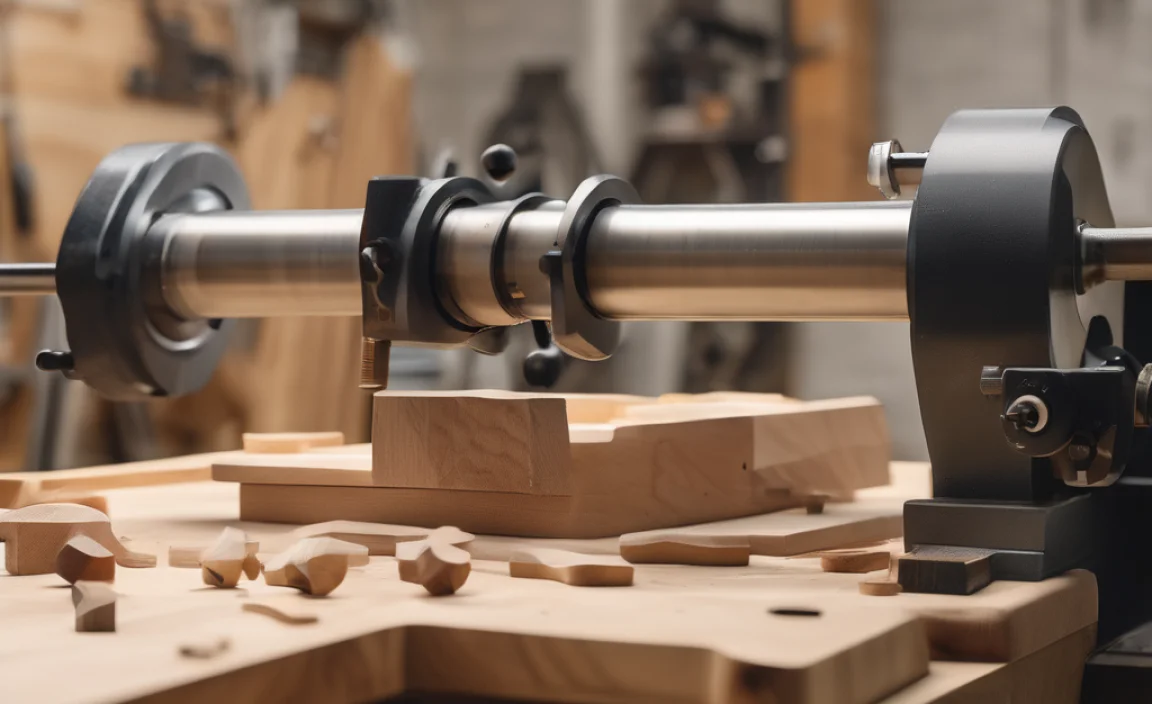For a beautiful, mirror-like finish on aluminum with a 1/8-inch carbide end mill, focus on proper speeds, feeds, coolant, and tool selection. This guide shows you how to achieve that polished result.
Getting a smooth, shiny finish on aluminum can be tricky. Sometimes, even with the right tools, your results look a bit rough. This often happens when the cutting conditions aren’t quite right, or the end mill isn’t perfectly suited for the job. Don’t worry, it’s a common challenge for beginners, and with a few key adjustments, you can achieve that sought-after mirror finish. This guide will walk you through everything you need to know, step-by-step, to make your aluminum parts look fantastic with a 1/8-inch carbide end mill. Let’s get started!
Understanding the 1/8-Inch Carbide End Mill for Aluminum
What Makes a 1/8-Inch Carbide End Mill Special?
A 1/8-inch carbide end mill is a precision cutting tool, meaning it’s designed with very specific dimensions and features. The “carbide” part tells us it’s made from a material called tungsten carbide, which is incredibly hard and durable. This hardness is crucial for cutting metals like aluminum effectively without dulling quickly. The “1/8-inch” refers to its diameter, a common and versatile size for detailed work. For aluminum, carbide is a fantastic choice because it can handle the higher speeds and forces needed for a clean cut.
When we talk about finishing aluminum, we’re aiming for a surface that’s smooth to the touch and reflects light like a mirror. This is often called a “mirror finish” or “optical finish.” Achieving this level of polish requires a tool that cuts cleanly and leaves minimal marks on the material. A good 1/8-inch carbide end mill, when used correctly, can do just that.
Why Aluminum Can Be Tricky
Aluminum is a relatively soft metal, which sounds like it should be easy to machine. However, its softness can lead to a problem called “chip welding” or “gumming up.” This is when the aluminum chips stick to the cutting edges of the end mill. When this happens, the tool can’t cut cleanly anymore, leading to a rough surface finish, increased heat, and potential damage to your tool or workpiece. Proper cutting parameters and the right type of end mill help prevent this.
The “Mirror Finish” Goal
A mirror finish isn’t just about looks; it can also be important for the function of a part. A smooth surface reduces friction, improves aerodynamics, or can be a precursor to further finishing processes like polishing. For hobbyists and makers, achieving this quality finish on their projects is a satisfying marker of skill and precision. Luckily, with the right approach, it’s entirely achievable even with a small tool like a 1/8-inch carbide end mill.
Choosing the Right 1/8-Inch Carbide End Mill
Key Features to Look For
Not all 1/8-inch carbide end mills are created equal, especially when you’re aiming for a mirror finish on aluminum. Here are the critical features to consider:
- Number of Flutes: For finishing aluminum, fewer flutes are generally better. Look for 2-flute or 3-flute end mills. More flutes (like 4 or 6) are typically for roughing or harder materials where chip evacuation is less of a concern than cutting performance. For a smooth finish on aluminum, 2 flutes are often preferred as they provide more aggressive chip clearance, reducing the chance of chip welding.
- Coating: While not strictly necessary for aluminum, some coatings can help. Uncoated carbide is often sufficient. If you see coatings like TiN (Titanium Nitride), it can offer mild improvements in hardness and reduce friction, but for aluminum, it’s less critical than for steel. A bright, polished flute finish is more important for smoothness.
- End Type: For general finishing, a flat end mill is standard. However, ball end mills can create radiused corners and smooth contoured surfaces. Square end mills have a sharp 90-degree corner, which is good for creating sharp edges. For a basic mirror finish on a flat surface, a flat end mill is your go-to.
- Helix Angle: A higher helix angle (e.g., 45 degrees or more) is generally better for aluminum. It provides a shearing action that cuts cleanly and helps to lift chips out of the cut, reducing rubbing and improving surface finish. A steeper helix angle also helps to reduce chatter.
- Material Grade: Standard tungsten carbide grades are usually fine for aluminum. Avoid very fine-grain carbides if possible, as smoother grades can contribute to better surface finishes.
Specific Recommendations for Aluminum
When specifically looking for an end mill for aluminum, you might see them advertised as “aluminum-specific” or “high-performance.” These often have:
- Polished flutes to help chips slide away easily.
- A higher helix angle (often 45° or even 60°).
- A specific carbide grade optimized for non-ferrous metals.
- A 2-flute design for maximum chip clearance.
For a 1/8-inch size, finding an “extra long” shank option can be beneficial for reaching into pockets or over features, but ensure it’s rigid enough for your milling machine to avoid vibration. A shank diameter matching the cutting diameter (e.g., 1/8-inch shank for a 1/8-inch cutter) offers good rigidity for smaller operations.
Where to Buy Quality End Mills
Reputable tool suppliers are key. Look for established brands known for their machining tools. Some excellent places to start include:
- Online Specialty Tool Retailers: Companies that focus specifically on cutting tools and machining supplies.
- Machine Tool Manufacturers’ Stores: If you own a specific brand of milling machine, their accessories division might offer recommended tooling.
- Industrial Supply Houses: Many have online storefronts and a wide selection of professional-grade tools.
When browsing, pay attention to the product descriptions. Keywords like “aluminum,” “high-performance,” “mirror finish,” “polished flute,” and “high helix” are good indicators.
Setting Up Your Milling Machine for Success
Machine Rigidity and Stability
A stable milling machine is non-negotiable for achieving a good finish. Even with a small 1/8-inch end mill, vibration is the enemy of a smooth surface. Ensure:
- No Loose Parts: Check that your machine’s vise, clamps, tool holder, and table are all securely tightened.
- Clean Ways: Make sure the machine’s ways (the surfaces that guide the movement of the table and head) are clean and lubricated.
- Collet Chuck: Use a high-quality collet chuck (e.g., ER collets) for your end mill. These provide excellent runout accuracy, ensuring the tool spins perfectly true. Avoid trying to hold the end mill directly in a drill chuck if possible; a collet chuck is far superior for milling.
Workholding: Securely Holding Your Aluminum
How you hold your aluminum workpiece is critical. It needs to be held so firmly that it absolutely cannot move during the milling operation. For a 1/8-inch end mill, you’re likely working on smaller parts or details. Common methods include:
- Milling Vise: A precision milling vise is ideal. Ensure the jaws are clean and the vise is securely bolted to the milling machine table. Use soft jaws if you’re concerned about marring the surface of your aluminum.
- Clamps: If your part has features that allow for it, use clamps. Ensure the clamps are tight and do not interfere with the end mill’s cutting path. Bridge clamps or strap clamps can be useful.
- Fixturing: For production runs or complex shapes, custom fixtures are best. These might involve dowel pins, stops, and machined pockets to locate and hold the part precisely.
For aluminum, especially while finishing, you want to avoid any slight movement. Even a tiny bit of “give” will translate into a poor surface finish.
Coolant and Lubrication: The Key to Preventing Chip Welding
This is arguably the most important factor when machining aluminum and achieving a mirror finish. Aluminum is notorious for sticking to the tool. Coolant or a suitable cutting fluid does two main jobs:
- Cools the Cutting Edge: Reduces heat buildup, which is a primary cause of chip welding.
- Lubricates: Helps chips slide away from the end mill and workpiece, preventing them from sticking.
In aerosol form, a “mist coolant” system can be very effective for small milling jobs. Alternatively, a flood coolant system or even a manually applied cutting fluid designed for aluminum can work. For very light finishing passes with a 1/8-inch end mill, a high-quality spray can of cutting fluid specifically formulated for aluminum can be sufficient. You can learn more about cutting fluids from resources like Machinist’s Edge, a reputable guide to machining practices.
What to use: Look for fluids that are specifically designed for aluminum or for general-purpose machining of soft non-ferrous metals. Avoid heavy oils that can make a mess and don’t cool efficiently. Some people use WD-40 for very light work, but dedicated cutting fluids are much more effective at preventing chip welding.
Dialing In Your Speeds and Feeds
Understanding Spindle Speed (RPM)
Spindle speed is how fast your milling machine’s spindle rotates, measured in revolutions per minute (RPM). For carbide end mills in aluminum, you generally want to run at a relatively high RPM. This higher speed helps create a shearing action that produces fine chips rather than relying on the tool to “plow” through the material. A good starting point for a 1/8-inch carbide end mill in aluminum is typically between 10,000 and 20,000 RPM.
Formula: The theoretical surface speed (SFM or SMM – surface meters/minute) is what the cutting edge travels.
SFM = (RPM x Diameter) / 3.82 (for inches)
SMM = (RPM x Diameter) / 3.18 (for mm)
Manufacturers often specify optimal SFM/SMM for their tools. For carbide in aluminum, this can range from 300-800 SFM (or even higher for specialty tools). For a 1/8″ (0.125″) diameter end mill:
- At 10,000 RPM: SFM = (10000 0.125) / 3.82 ≈ 327 SFM
- At 20,000 RPM: SFM = (20000 0.125) / 3.82 ≈ 654 SFM
So, a 10,000-20,000 RPM range is a good starting point.
Setting Your Feed Rate (IPM)
Feed rate is how fast the cutting tool moves into the material, measured in inches per minute (IPM) or millimeters per minute (MPM). This is crucial for chip load – the amount of material each cutting edge removes per revolution. For a good finish:
- Chip Load is Key: You want a chip load that’s large enough to produce a clean chip, but not so large that it overloads the tool or causes excessive heat. A typical target chip load for a 1/8-inch carbide end mill in aluminum is around 0.0005 to 0.0015 inches per tooth (IPT).
- Calculate Feed Rate: Feed Rate (IPM) = RPM × Number of Flutes × Chip Load (IPT)
Example: For a 2-flute end mill at 15,000 RPM with a chip load of 0.001 IPT:
Feed Rate = 15,000 RPM × 2 flutes × 0.001 IPT = 30 IPM
If you’re using a 3-flute end mill, you may need to adjust accordingly or use a slightly lighter chip load per tooth if the feed rate becomes too high for your machine’s stepper motors or rigidity.
Depth of Cut (DOC) and Width of Cut (WOC) for Finishing
For achieving a mirror finish, the final pass (the “finishing pass”) is critical. This is where you remove very little material to achieve that smooth surface.
- Depth of Cut (DOC): Keep the depth of cut very small for the finishing pass. Think 0.001 to 0.005 inches. The goal is just to shave off any minor imperfections left by previous passes. For roughing or semi-finishing, you can take much deeper cuts (e.g., 0.1x to 0.5x the tool diameter, depending on rigidity and material).
- Width of Cut (WOC): For finishing flat surfaces, a full-width cut (WOC = 100% of tool diameter) is common. For pocketing or contouring, a WOC of around 50% of the tool diameter is often used. For a mirror finish, sometimes a slightly lighter WOC can help reduce forces and improve surface quality.
Using a CNC Milling Machine vs. Manual Machine
CNC Machines: Offer the greatest precision and repeatability. You can program exact speeds, feeds, and paths, making it easier to achieve consistent mirror finishes. Modern CNCs often have features like high-RPM spindles and sophisticated coolant systems that are ideal for this task. For those new to CNC, resources like CNCCookbook provide excellent guides on programming and operation.
Manual Machines: Require more skill and constant attention. You’ll be manually setting speeds and feeds with handwheels. Achieving a consistent mirror finish on a manual mill relies heavily on the operator’s feel, experience, and a good understanding of the machine’s capabilities. Using dro’s (digital readouts) for precise movements and a keen ear for tool sound are essential.
Step-by-Step Guide to Achieving a Mirror Finish
Step 1: Prepare Your Workpiece and Machine
Ensure your aluminum workpiece is securely held in your milling vise or fixture. Clean any cutting oil or debris from previous operations. Make sure your milling machine is clean, lubricated, and all components are locked down. Install a high-quality collet chuck with your 1/8-inch carbide end mill.
Step 2: Set Up Your Coolant/Lubrication
Turn on your mist coolant, flood coolant, or prepare to manually apply your chosen cutting fluid for aluminum. Ensure the nozzle is positioned to deliver coolant directly to the cutting zone. For manual application, have your spray bottle or applicator ready.
Step 3: Perform a Roughing Pass (Optional but Recommended)
If your part has significant material to remove, start with a roughing pass. Use optimal speeds and feeds, and a more aggressive DOC and WOC. This pass removes most of the material and leaves a surface that is easier to finish.
- Example Roughing Parameters:
- RPM: 10,000 – 15,000
- Feed Rate: 20 – 40 IPM
- DOC: 0.05 – 0.2 inches (adjust based on machine rigidity)
- WOC: 50% – 75% of tool diameter
Step 4: Perform a Semi-Finishing Pass
Follow the roughing pass with a semi-finishing pass. This cleans up the surface left by the roughing pass and prepares it for the final mirror finish pass. Reduce DOC and slightly increase feed rate for a better chip load.
- Example Semi-Finishing Parameters:
- RPM: 15,000 – 20,000
- Feed Rate: 30 – 50 IPM
- DOC: 0.005 – 0.02 inches
- WOC: 50% – 75% of tool diameter
Step 5: The Mirror Finishing Pass
This is the crucial step. Use very light cuts and the correct parameters to achieve that polished look.
- Finishing Pass Parameters:
- RPM: 18,000 – 25,000+ (higher is often better for a mirror finish on aluminum if your machine can handle it)
- Feed Rate: 30 – 60 IPM (aim for a chip load of 0.0005 – 0.001 IPT per tooth)
- DOC: 0.001 –



